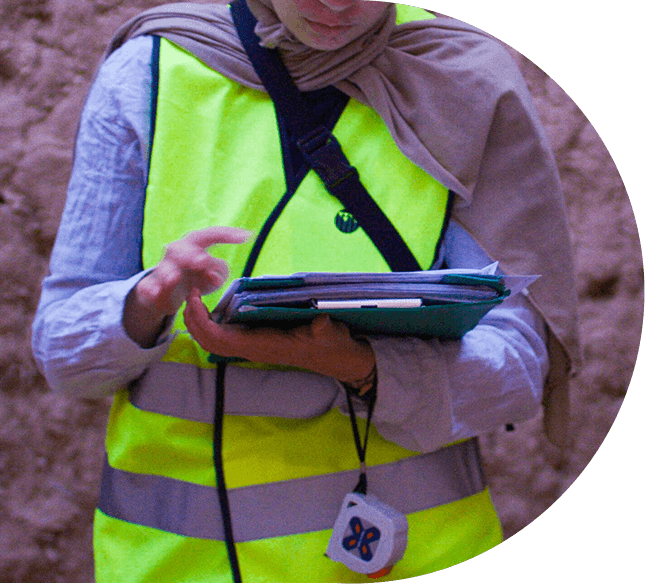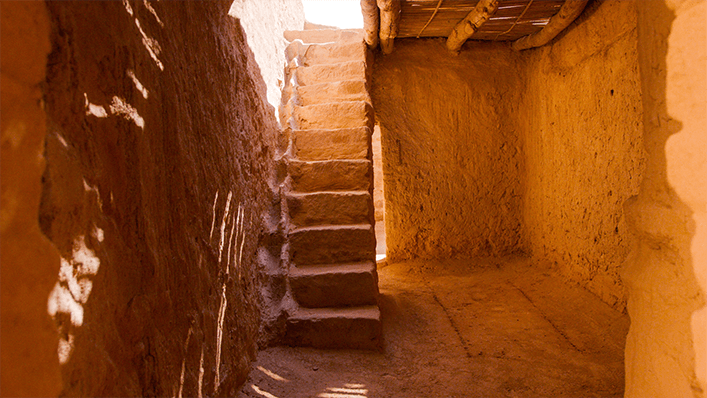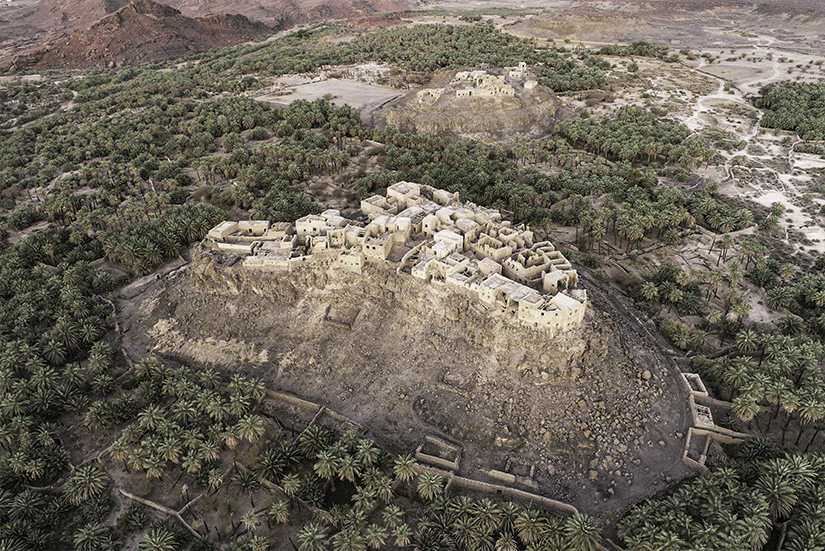0

0




ENVIRONMENT & INFRASTRUCTURES
READ




AGRICULTURE
READ




BOTANICS
READ


MORE DETAILS

A little further into the valley, Dr. Louise Purdue,
a research associate at the CNRS, geoarchaeologist
and agronomist, has her eyes on the water and
the soil. Surrounded by geophysicists and geomorphologists, she and her team use surveying and core sampling to search for the valley's ancient hydroagricultural systems.
The valley was also used for more than growing
date palms. Pomegranate trees, olive trees, barley,
wheat, lentils, garbanzo beans, and cotton – despite
its high water usage – were also grown there.
This information is precious to the Afalula
Agriculture division's work to revive and develop
sustainable local agriculture industries within
the valley; just one example of this is the ability
of archaeological disciplines to power
the future.
« Phases of agricultural operations during the Dadan and Nabataean periods have been uncovered, with fertile and fruitful soils »

We can find the researchers of the MuDUD project, lead by Apolline Vernet, helmets tightly fastened, tending to AlUla’s old town, an inextricable and sublime tangle of cubic mud-brick houses, abandoned in the early 1980s. Inseparable from the oasis, this ghost city, silent witness to a multi-secular know-how and way of life, is also the subject of a historical study. Data coming from stratigraphy and building archaeology, together with CRAterre’s expertise on raw earth architecture, are already informing the thoughts of the urban planners and architects responsible for the oasis’s development.

Responsible for mapping the oasis as part of the UCOP project (AlUla Cultural Oasis Project), Dr. Julien Charbonnier, from the Archaïos society, gradually persuades these ruiniform silhouettes to speak, allowing us a glimpse of the contours of this historic oasis: a constellation of plots in the shape of a walled garden, accessed by an impressive network of alleyways, a maze of canals and qanats - underground galleries draining water from the groundwater table - and wells, as well as farms, public baths, and mosques. “The first prospecting campaigns revealed a structure very similar to urban rules, nearly mirroring that of the old town,” the scientific director for the UCOP project states. Ingrid Périssé-Valéro adds: “Over the course of five seasons of studies, more than 11,000 archaeological structures have already been identified, and nearly 51,000 objects have been collected from the surface by the UCOP team.”
« We need archaeological data to help us devise development solutions. »
Jean-François Charnier,
Scientific Director of Afalula, Head of the Culture
and Heritage Division
For the first time, this vibrant heritage,
this ecosystem that is as special as it is fragile,
is being studied from every angle as part of a
cross-disciplinary archaeological survey.
Archaeologists, archaeobotanists, geoarchaeologists, zooarchaeologists, anthropologists, and even urban planners and other specialists in biogenetics, water,
and agriculture are pooling their knowledge and
techniques to understand the history of AlUla’s
oasis and its evolution over the centuries.
For the first time, this vibrant heritage, this ecosystem that is as special as it is fragile, is being studied from every angle as part of a cross-disciplinary archaeological survey. Archaeologists, archaeobotanists, geoarchaeologists, zooarchaeologists, anthropologists, and even urban planners and other specialists in biogenetics, water, and agriculture are pooling their knowledge and techniques to understand the history of AlUla’s oasis and its evolution over the centuries.





However, beneath the shade of the date palms, rooted in the wadi of AlUla, is where a unique synergy of multiple areas of expertise comes to life.


In this rich oasis resting 250 km south of the AlUla valley and surrounded by ancient citadels and abandoned settlements, the cross-disciplinary team, co-led by Dr. Guillaume Charloux and Dr. Rémy Crassard, CNRS researchers, and Munirah al Mushawah, archaeologist at the Royal Commission for AlUla, are enthusiastic about the initial discoveries. Here, gigantic animal traps, ancient tombs, and other prehistoric megaliths are side by side with an impressive pre-Islamic rampart 11 km long, together with villages, forts, and an old caravansary from the Islamic period. The environment that enabled such longstanding human presence is already the subject of geological and geomorphological studies. In future expeditions, zooarchaeological and archaeobotanical research will focus on the flora and fauna.

OTHER PROMISING EXCAVATIONS HAVE BEEN LAUNCHED AT KHAYBAR.
READ MORE



Brushes and trowels are hard at work on everything from the necropolis to the vast sanctuary dedicated to the Dadanite god Dhu-Ghabat, passing through the living quarters as well as the Islamic occupation area. Among other surprise discoveries, with the help of some professional climbers, researchers managed to uncover another sanctuary along the steep heights of Jabal Khuryabah, as well as forts from the Islamic period. On the ground in Dadan, we also encounter the architects and restorers from CRAterre, who are responsible for the overall conservation plan of the site, which is designed to welcome the public in the future.

THE FRANCO-SAUDI MISSION RESPONSIBLE
FOR STUDYING THE DADAN SITE, CO-LED BY
DR. JÉRÔME ROHMER (CNRS) AND DR. ABDULRAHMAN ALSUHAIBANI (KING SAUD UNIVERSITY),
IS FULL OF PROMISE.
THE FRANCO-SAUDI MISSION
RESPONSIBLE FOR STUDYING
THE DADAN SITE, CO-LED BY
DR. JÉRÔME ROHMER (CNRS)
AND DR. ABDULRAHMAN
ALSUHAIBANI (KING SAUD
UNIVERSITY), IS FULL
OF PROMISE.
READ MORE



The expert hands of the French restorers who worked on the Winged Victory of Samothrace at the Louvre are helping to clean the modern inscriptions, whether painted or engraved. This presents an opportunity for these world-renowned experts to train local students in restoration techniques and heritage preservation.

IN HEGRA, THE ICONIC CAVE TOMBS ARE REVEALED
AS PART OF THE GRAFFITI PROJECT.
READ MORE




No fewer than 120 French and international archaeologists and researchers work in the valley, excavating the treasures of the past and retracing the fascinating epic of this garden in the middle of the desert. We see them in large numbers across the emblematic sites of Dadan, the Oasis, and the Old Town; the future Kingdoms Institute will collect the results of their research. “The strength of the Agency lies in bringing talented researchers from major French institutions like the CNRS [French National Center for Scientific Research], the Sorbonne, and the National Museum of Natural History to the project,” Ingrid Périssé-Valéro clarifies. Under the impetus of the RCU, the region also attracts other renowned players, like the International Center on Earthen Architecture called CRAterre or the society of scientific research in archaeology known as Archaïos.
« The revelation of AlUla’s cultural importance is very much needed today, as there is a marked lack of visibility and international recognition of the rich heritage behind this exceptional site. Afalula is undertaking a scientific project on historiography, or the exploration, knowledge, and formalizing of historical narratives. Today, in the absence of archives, these stories are sought from deep within the soil of the AlUla sites. Our objective was to provide experts with high-level research and who had knowledge of local issues in the AlUla region.
The archaeologists share in a sensitive look at the project, both from an intellectual, philosophical, and artistic standpoint, which is specific to French expertise. »
Jean-François Charnier,
Scientific Director of Afalula,
Head of the Culture and Heritage Division
« The revelation of AlUla’s cultural importance is very much needed today, as there is a marked lack of visibility and international recognition of the rich heritage behind this exceptional site. Afalula is undertaking a scientific project on historiography, or the exploration, knowledge, and formalizing of historical narratives. Today, in the absence of archives, these stories are sought from deep within the soil of the AlUla sites.
Our objective was to provide experts with high-level research and who had knowledge of local issues in the AlUla region. The archaeologists share in a sensitive look at the project, both from an intellectual, philosophical, and artistic standpoint, which is specific to French expertise. »
Jean-François Charnier,
Scientific Director of Afalula,
Head of the Culture and Heritage Division

Several expeditions entailing systematic excavations and heritage studies led by the French Agency for AlUla development (Afalula), in partnership with the Royal Commission for AlUla (RCU), were launched in 2019. HH Prince Badr bin Abdullah bin Mohammed bin Farhan Al Saud, the Kingdom’s Minister of Culture, then stated a clear ambition on behalf of Saudi Arabia. Archaeological work, insofar as it reveals the historical potential of this region, should help AlUla become a world-class destination.











3 The advent of Islam
3 The advent of Islam




2 The Dadanite and Lihyanite kingdoms
2
The Dadanite
and Lihyanite
kingdoms



1 Neolithic peoples
1 Neolithic
peoples


Set in motion by the excavations carried out on the ancient site of Hegra, Franco-Saudi archaeological expeditions have gradually, over a period of around twenty years, unveiled these fabulous remnants, the heirs to a long history of at least 7,000 years.
« That’s what’s so exciting here in AlUla: we’re on a blank page, perhaps similar to 19th-century Greece or Mesopotamia, where everything has yet to be done, discovered, studied, and revealed to the public »
Ingrid Périssé-Valéro,
Director of Archaeology and Heritage at Afalula.
This valley, forgotten by the world for centuries, can be explored today with the soul of a pioneer, in the wake of such famous travelers as Ibn Battuta and Lawrence of Arabia.


Red sandstone canyons and basalt plateaus, a deep green oasis surrounded by golden sand and strange rocks that look as if they've fallen from the moon, planted like sentinels in the vastness of the desert: AlUla, a valley of wonders carved like a piece of land art deep in the heart of the Hijaz mountains, can be found in the northwest of the Arabian Peninsula. Inscriptions engraved in sandstone, intriguing petroglyphs, monumental troglodyte tombs, medieval fortresses, and places of worship punctuate this immense territory where the sheer density of relics is staggering. A foray into the valley thus becomes a journey through time as you follow in the footsteps of the Bronze Age ostrich hunters, the camel caravans along the ancient incense trade route, and the medieval pilgrims on the road from Damascus to Mecca.




Large format


It all begins with the Neolithic peoples, whose cave art marks the mountain of Jabal Ikmah. Thanks to its water resources and its position as a crossroads, the AlUla valley was fertile ground for brilliant civilizations.




The monumental statues recently discovered embedded in the red of the rock at the Dadan site hint at the splendor of the ancient capital of the Dadanite and Lihyanite kingdoms, masters of the myrrh and incense trade in the 1st millennium BC. More masterfully still, the grandiose and delicately crafted tombs of ancient Hegra, established in the 1st century BC, exalt the genius and power of the Nabataeans.




After the advent of Islam in the seventh century AD, the new towns Al-Mabiyat and then AlUla rose from the ground and absorbed the flow of pilgrims gathering water and dates in the area. This river valley (wadi) carries great swathes of Arabian Peninsula history in its waters.

In the Old Town of AlUla, the planned archaeology is being paired with preventive archaeology, also known as salvage archaeology, which supports the development of the reconstruction of this dwelling abandoned in the early 1980s.
Several students from the major universities of Saudi Arabia and France are participating in various projects, where they learn about the methods and tools that will make them the experts of the future.
In reality, archaeologists only spend 30% of their time in the field. Most of their time is spent on preparing for excavations, analyzing, taking inventories, and writing reports. While both meticulous and time-consuming, this work is also indispensable for moving forward with research.




















BACK TO HOMEPAGE
TOP OF PAGE
NEXT

Stratigraphy : observation of archaeological layers.


Building archaeology : analysis of the different construction techniques and phases of a wall.









HARRAT ALZABN
HARRAT UWAYRID
NAKHLA RESERVE
SHARAAN RESERVE
ALGHARAMEEL RESERVE


Mughayra
Al Atheeb
Elephant Rock
Ashar
AlJadidah
Belvedere
Hegra
Al Hijr
An overview of the outstanding
projects that will turn AlUla
into a major cultural
destination.












Villa Hegra
Language Institute

Airport
Al Motadil
Banyan Tree
Maraya

Habitas
Shaden Resort
Dadan
Sharaan Reserve
Moringa Laboratory


